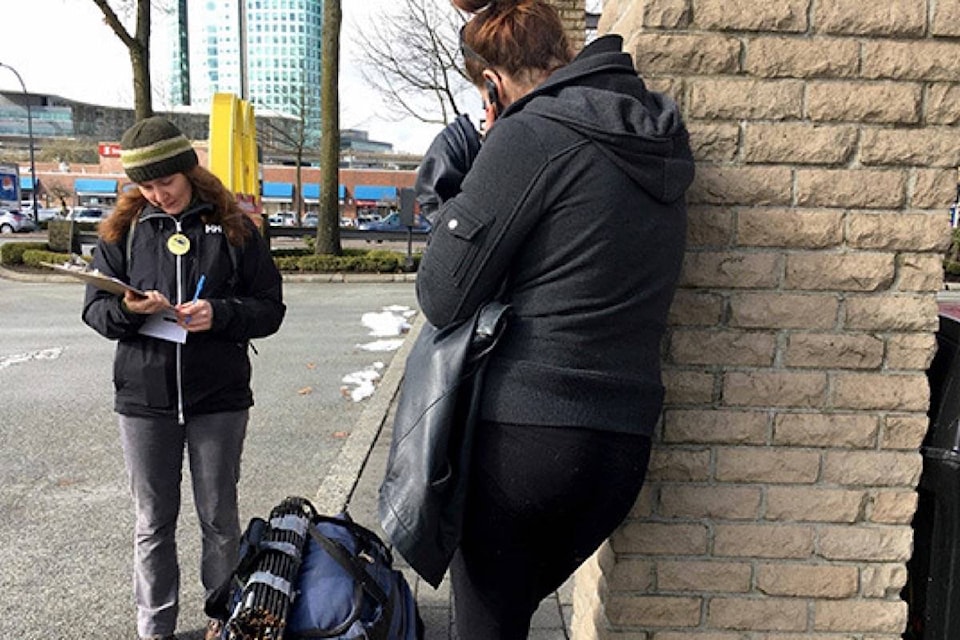A recent forum with Surrey’s Vulnerable Women and Girls Working Group highlighted the need for a nighttime drop-in location for women working in the sex trade, but trying to find the right location can be a “struggle.”
Bonnie Moriarty, co-chair of the Surrey Vulnerable Women and Girls Working Group, said a forum on June 18, brought together women with “lived experience” in the sex trade, local politicians and not-for-profits.
It was meant to find out what are some of the priorities for what’s happening on the streets, including a report from vulnerable women and girls and what they wanted, Moriarty said.
“It was evident that, certainly, a nighttime drop in is what people were interested in,” said Moriarty. “There was a real focus, I think, that was clear. Without us even asking and saying this is what we want — it kind of came out of that.”
She said the forum discussed models of what the drop in could look like, such as working with people with “lived experience in the sex trade that would be very active in participating in the running of the drop in.”
READ ALSO: North Surrey women’s housing facility ‘almost immediately’ at capacity, Nov. 27, 2018
With the forum, Moriarty said she hopes it will get a plan together for a drop-in centre.
“If you think about a drop in, particularly where women are coming off the street, it would have to be in a specific area because community often doesn’t want it in residential areas or in highly condensed business areas — that’s always the struggle with where it would be allowed,” she said.
However, there is an issue with some of the women being “scattered out” throughout the city.
“That’s the problem with Surrey, it’s so spread out and we don’t even know sometimes where women are,” she said.
The working group has its SMART (Surrey Mobile Assault Response Team) Van that drives around four to six nights a week from about 10 p.m. to 2 a.m., trying to help serve women working on the street. It’s modelled after WISH Vancouver’s MAP (Mobile Access Project) Van.
READ ALSO: 60 homeless people admitted to Surrey Memorial Hospital ‘on any given day’: councillor, May 11, 2019
Moriarty said WISH came out to Surrey with its van initially and she said she was told Surrey has the “same amount of women on the street as they do in Vancouver.”
“The interesting thing about Surrey, if you think about it, is Surrey is so spread out, women are in different kind of pockets of the area and that’s the real danger because they’re often really isolated and kind of with nobody else around in areas that are unsafe,” Moriarty said.
“Not to say that doesn’t happen in Vancouver, but there’s a real concentrated area, I think, in Vancouver where they’re around other people. There’s some accountability.”
Michelle Ninow, the social planning consultant, said the Vulnerable Women and Girls Working Group was able to learn from WISH.
“We did the research to make sure that model would work in Surrey. It’s actually the thing that made the most sense to get going as soon as we could,” said Ninow, adding that because Surrey is so large, it’s hard to serve everyone from one location.
Ninow said it came up that the women would “really love” to see the SMART Van out on the street all night long and until daylight.
Also during the forum, Ninow said the participants asked, “What does safe and accessible service look like for mean to you?”
She said the women said it should feel like “a community” where people know you, along with female staff in a facility that is well-maintained and clean.
“With people around when you need it and they watch out for you,” she said. “The staff know the women coming in, they have a connection to them – a personal connection –so they can build on that personal connection, get to know the women and know what they need in order to get their needs met and get more stability in their life.”
The Surrey Vulnerable Women and Girls Working Group was formed in 2013 after a homeless woman, Janice Shore, was beat to death in Surrey, according to the City of Surrey’s website.
“As her story emerged afterwards, it became clear that Janice’s struggles with mental illness and addictions had increased her vulnerability and the challenges that she faced to meet her daily needs and stay safe.”
Afterward, non-profits and government representatives came together to “pool their knowledge and build their understanding of the unmet needs and challenges faced by vulnerable females in Surrey.”
The working group includes seven not-for-profits (Elizabeth Fry Society, Options Community Services, Lookout Emergency Aid Society, Pacific Community Resources Society, Atira Women’s Resource Centre, YWCA and Surrey Women’s Centre), along with the City of Surrey, Surrey RCMP, Fraser Health, BC Housing, the Ministry of Children and Family Development and Public Safety Canada.
READ ALSO: The struggles and successes of Surrey’s homeless housing project, Nov. 6, 2018
